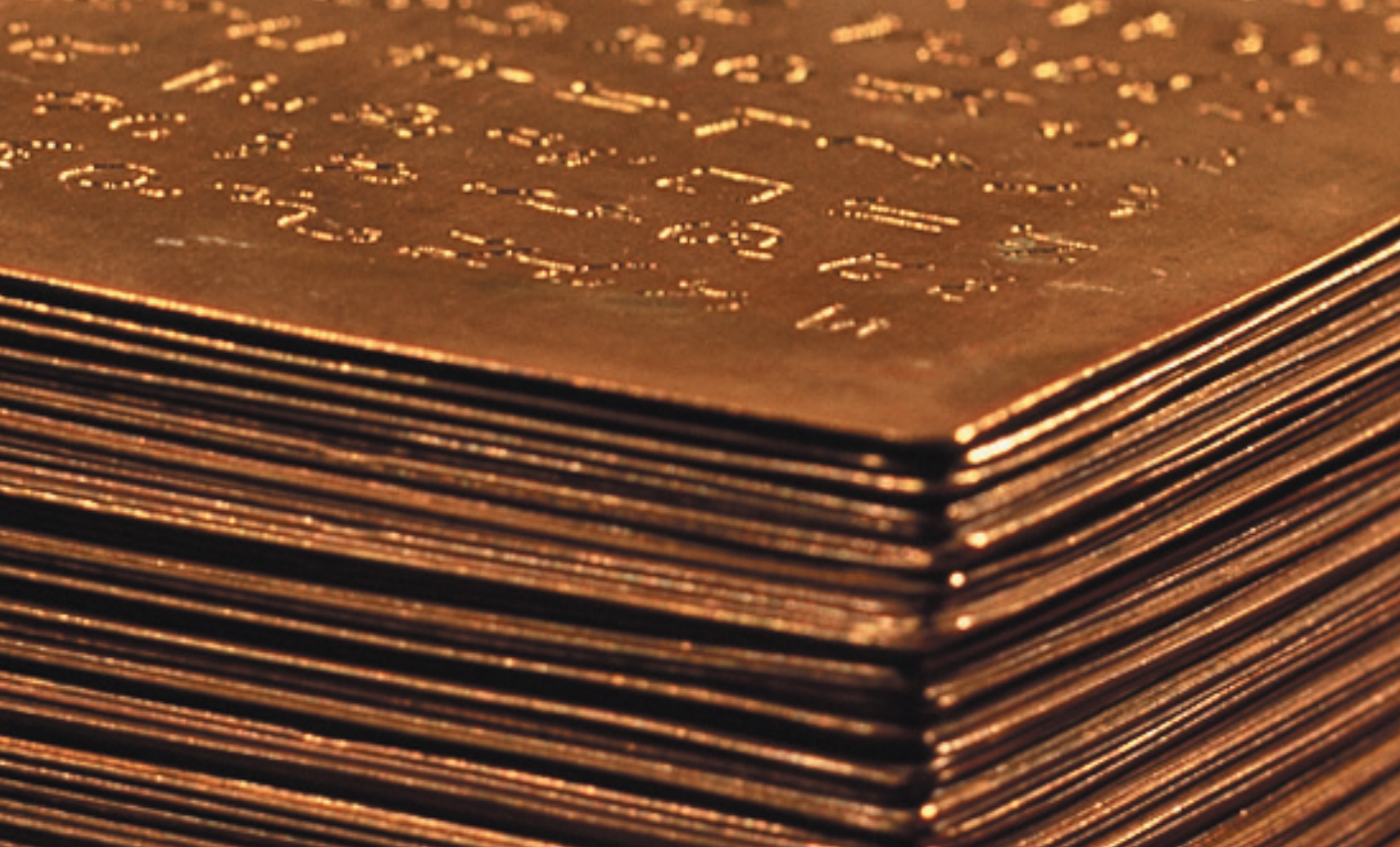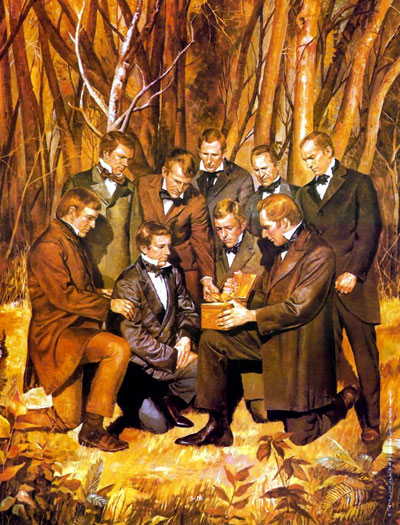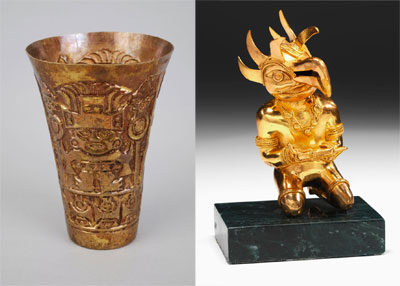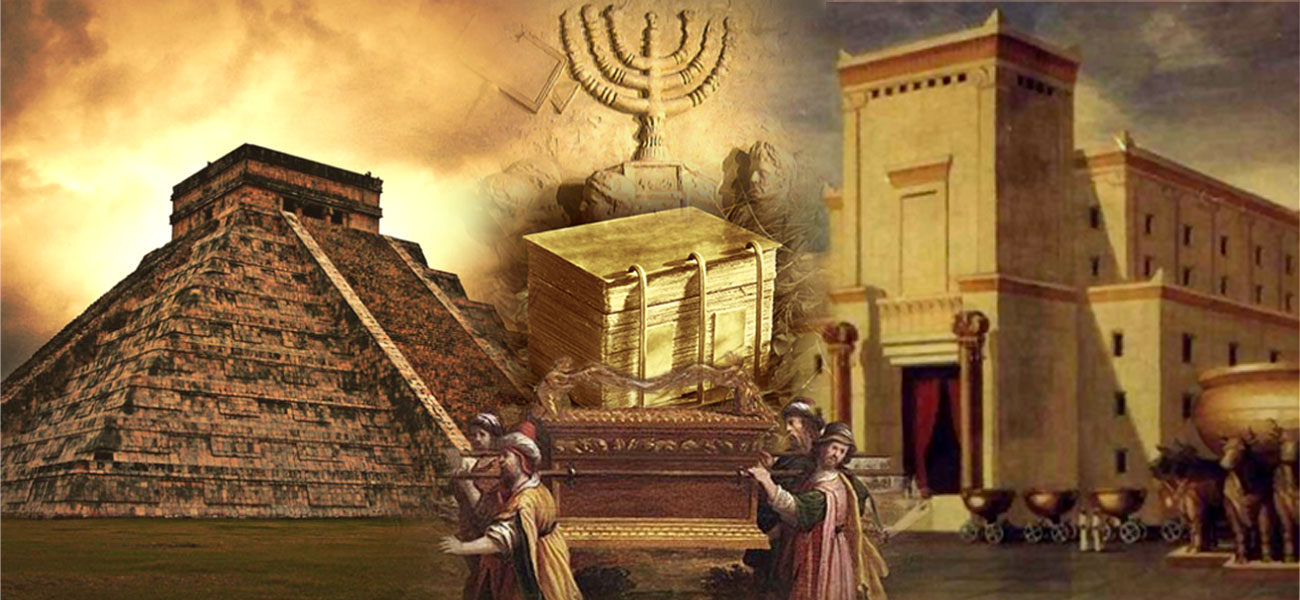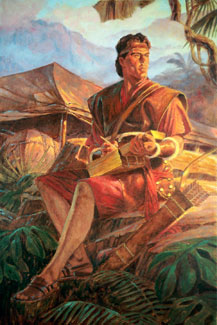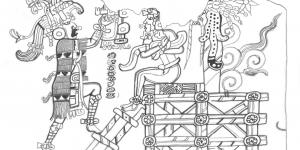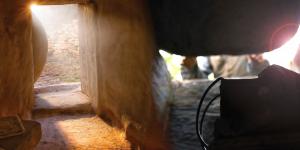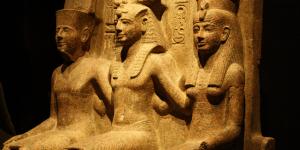You are here
What Kind of Ore did Nephi Use to Make the Plates?

1 Nephi 19:1
The Know
Shortly after arriving in the New World, Nephi reports making “plates of ore” to engrave his account on (see 1 Nephi 19:1). Although he does not tell us specifically which kind of ore he used, just before making the plates he mentions finding “all manner of ore, both of gold, and of silver, and of copper” (1 Nephi 18:25).1
Today, readers typically read these statements separately, due to the chapter divisions made by Orson Pratt in 1879. In the original Book of Mormon, however, there was no chapter break between 1 Nephi 18:25 and 19:1.2 Thus, one can agree with Book of Mormon scholar Brant A. Gardner that there may well be “a direct connection between finding ore and creating the plates.”3
As it turns out, an alloy that was called tumbaga by the Spanish was known in pre-Columbian Mesoamerica. Tumbaga generally consisted of copper, gold, and sometimes silver—the same three metals Nephi explicitly mentions finding before making his plates. As early as the 1960s, metallurgical technician Read H. Putnam suggested that this alloy may be the material used to make the Book of Mormon plates.4
Some considerations lend strength to this idea. Those who lifted the plates estimated their weight to be about 40–60 lbs. Plates of that size made of pure gold, however, would have weighed even more. If made of tumbaga, Putnam estimated the plates could have weighed about 53 lbs.5
More recent work by geologist and engineer Jerry Grover suggests a weight range of between 53–58 lbs. Grover also determined that the plates must have been approximately 90% copper, 8% gold, and 2% silver. Otherwise they would have weighed too much.6
What about the color of tumbaga? Eyewitnesses described the plates as being “golden” or having “the appearance of gold.”7 William Smith, however, did say that the plates consisted of “a mixture of gold and copper.”8 While the alloy was naturally a reddish color, it was commonly made to look golden by leeching out the copper on the surface.“9
The Why
Plates of tumbaga make a lot of sense, for several reasons. Gold is too soft, and thin gold plates would not hold up well. The copper makes tumbaga more rigid and resilient, even in thin sheets.10Moreover, the thin gold surface that appears after the gilding process would have made the plates easy to engrave, and would also have protected the surface from rust and corrosion.11
According to Nephi, he was preparing a record of the “more sacred things,” and he only ever wrote things on his small plates that were of sacred significance (1 Nephi 19:5–6). In the temple or tabernacle of ancient Israel, most of the most sacred objects were gold or gold plated12. These sacred words and objects were most highly valued and making them of the most precious ore reminded all who saw them of their enormous, eternal value.
Nephi prepared his small plates as his people were completing the construction of a temple “like unto Solomon’s temple” (2 Nephi 5:16; cf. vv. 28–32). Numerous connections have been made between Nephi’s account and the temple.13 As a temple text, the plates on which Nephi made his sacred record would also have been a temple object. These holy records were handed down in the priestly lineages of Jacob and then of Alma.
Thus, the nature of tumbaga served the purposes of the Lord, practically, functionally, meaningfully, symbolically, and spiritually. This alloy readily available to Nephi allowed him, and other record-makers mentioned throughout the Book of Mormon, to make plates that would have the necessary utility for engraving records while also having the proper golden appearance of a sacred temple object.
Further Reading
Jerry D. Grover Jr., Ziff, Magic Goggles, and Golden Plates: The Etymology of Zyf and a Metallurgical Analysis of the Book of Mormon Plates (online PDF, 2015).
Kirk B. Henrichsen, “How Witnesses Described the ‘Gold Plates’,” Journal of Book of Mormon Studies 10, no. 1 (2001): 16–21.
John L. Sorenson, “Of What Material Were the Plates?” Journal of Book of Mormon Studies 10, no. 1 (2001): 21.
Robert F. Smith, “The ‘Golden’ Plates” in Reexploring the Book of Mormon: A Decade of New Research, ed. John W. Welch (Provo, Utah: FARMS, 1992), 275–277.
Read H. Putnam, “Were the Golden Plates made of Tumbaga?” Improvement Era 69, no. 9 (September 1966): 788–789, 828–831.
- 1. The wording of 1 Nephi 18:25 can be somewhat confusing, since it uses “both” and then lists three different ores. Jerry Grover, a professional geologist, explains, “Native gold and silver nearly always occur together as one ‘ore’ in nature. Technologies to separate gold and silver (called ‘parting’) were not known to be practiced in the Old World before the fifth century B.C …. There has been no evidence discovered in the New World that any pre-Columbian culture possessed gold and silver separation technologies.” Thus, Grover explains, “the most consistent reading of the scriptural passage above is a binary ore of gold and silver, with the additional separate ore being copper.” Jerry D. Grover Jr., Ziff, Magic Goggles, and Golden Plates: The Etymology of Zyf and a Metallurgical Analysis of the Book of Mormon Plates (online PDF, accessed November 13, 2015), 79.
- 2. Joseph Smith, The Book of Mormon: An Account written by the Hand of Mormon, Upon Plates taken from the Plates of Nephi (Palmyra, NY: E.B. Grandin, 1830), 50.
- 3. Brant A. Gardner, Second Witness: An Analytical & Contextual Commentary on the Book of Mormon, 6 vols. (Salt Lake City, Utah: Greg Kofford Books, 2007–2008), 1:357.
- 4. Read H. Putnam, “Were the Golden Plates made of Tumbaga?” Improvement Era 69, no. 9 (September 1966): 788–789, 828–831. This was based on a presentation given at the Fifteenth Annual Symposium on the Archaeology of the Scriptures, May 16, 1964. See UAS Newsletter no. 90, July 21, 1964.
- 5. Putnam, “Were the Golden Plates made of Tumbaga?” 830. This assumes an 8-karat gold alloy, with about 24% gold, 73% copper, and 3% silver, and 50% air space.
- 6. Jerry D. Grover Jr., Ziff, Magic Goggles, and Golden Plates, 74–105. Grover used the eyewitness descriptions, sampling of pre-Columbian tumbaga artifacts, known ancient metallurgical techniques, and direct testing of metal sheets of copper and copper alloyed with gold and silver to test Putnam’s assumptions.
- 7. See Kirk B. Henrichsen, “How Witnesses Described the ‘Gold Plates’,” Journal of Book of Mormon Studies 10, no. 1 (2001): 17.
- 8. William Smith, The Saints’ Herald, October 4, 1884, 644; as cited in Henrichsen, “How Witnesses Described the ‘Gold Plates’,” 17.
- 9. Of What Material Were the Plates?” Journal of Book of Mormon Studies 10, no. 1 (2001): 21, explains: “It is of interest that tumbaga was commonly gilded by applying citric acid to the surface. The resulting chemical reaction eliminated copper atoms from the outer .0006 inch of the surface, leaving a microscopic layer of 23-karat gold that made the object look like it was wholly gold” (spelling silently corrected). It is important to clarify that in pre-Columbian America, only the use of oxalic acids is documented for use in depletion gilding. Furthermore, if the plates contained silver (as suggested by 1 Nephi 18:25), acid gilding would not have removed the silver from the surface. Alternative methods for gilding would have been necessary, such as the application of special aqueous pastes or a solution of alum, iron sulphate and salt at room temperature. After ten days, the surface was washed with a salt solution and then heated to convert the spongy surface to a smooth, compact, richly golden surface. There are also other methods available that would have removed the copper, silver, and other impurities from the surface. (Jerry Grover, personal communication, December 13, 2015).
- 10. Robert F. Smith, “The ‘Golden’ Plates” in Reexploring the Book of Mormon: A Decade of New Research, ed. John W. Welch (Provo, Utah: FARMS, 1992), 275–277. As an alternative to tumbaga, Jerry Grover (via personal communication, December 13, 2015) suggests the plates could have been simply copper covered in a thin layer of gilded gold. This practice is also attested in Mesoamerica.
- 11. The gold gild may have worn off on the edges, allowing for the oxidation of the edges. Josiah Stowell reportedly saw a small corner of the plates when part of the frock Joseph was covering them in slipped away. He said the plates “resembled a stone of a greenish caste,” which is consistent with the plates being made of a copper alloy which had oxidized. See Morning Star 8, no. 29 (Limerick, Maine; November 16, 1832).
- 12. These include the ark of the covenant, the incense altar, the table of the bread of the presence, the menorah, and the cherubim. See William J. Hamblin and David Rolph Seely, Solomon’s Temple: Myth and History (New York: Thames and Hudson, 2007), 19–20, 25.
- 13. See, for example, LeGrand L. Baker and Stephen D. Ricks, Who Shall Ascend into the Hill of the Lord? The Psalms in Israel’s Temple Worship in the Old Testament and in the Book of Mormon (Salt Lake City, Utah: Eborn Books, 2011), 466–471; Joseph M. Spencer, An Other Testament (Salem, Oregon: Salt Press, 2012), 41–57; John W. Welch, “When Did Nephi Write the Small Plates?” in Pressing Forward with the Book of Mormon: The FARMS Updates of the 1990s, ed. John W. Welch and Melvin J. Thorne (Provo, Utah: FARMS, 1999), 75–77.
KnoWhy Citation
Related KnoWhys
Subscribe
Get the latest updates on Book of Mormon topics and research for free

